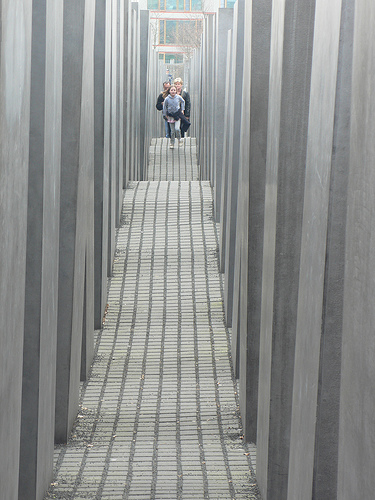* Labyrinth were sometimes used as a way to punish prisoners, and many of them died inside because they didn’t managed to find the exit.
* The point here is that a maze can be considered many as a prison or a way to be trapped, taking the freedom away, and bringing a claustrophobic feeling. Mazes are even used in many pshycological tests to demostrate the tendence of independence that one has.
* There is also a phenonenom called “mental maze”, which means that the pacient has a limited vision of the world, is trapped in a mental illness to be psychollogically disturbed. An example of that is a case of a father that locked his daugter in the basement of the house for 24 years, in Austria, and the girl in the end needed 1 month of psychological treatment to answer the questions that the police made to her.
* 2.- Just as we saw in the interview with Imre Kertész, there is a comparisson between the labour camps and the labyrinths. Both have very similar functions , not specific ones but according to the message they want to transmit. Labour Camps and mazes have very similiar architecture, they are usually closed spaces with one entrance that was used as an exit too; they where made specially for locking up someone inside so they has solid mechanisms such as walls and paths.
* Both camps and mazes change people, insert fear in them. Both of them lows the self-esteem in prisioners, and increase the claustrophobia. Having this conditions, anyone who is inside can be considered a slave of his own mind.
* It is because of this that many people (Jews for example) that were on the labour camps didn’t even manage to complain about their living conditions, because they knew they were trapped. Some people even commited suicide because of this; their freedom was taken away along with their dignity . This atrocities can be perfectly compared to slavery, and if not it’s definitely worse.
* 3.- In chapter 8, there are 2 mazes that can be found: the physical and the psychological one.
* The first one can be found clearly all along the chapter; it’s the Buchenwald concentration camp. It’s well known due global history that this was one of the principal camp in the whole holocaust. So this would the first maze in the chapter; the physical space in which Georg Koves is in, one that doesn’t allow him even think in get out of there. He was under constant surveillance, and slept in a very close space with alot of other children; and made a friend that was a prisoner doctor, that felt affection for children that spoke french; and later on he establishes friendship with Georg.
* The second one is the psychological maze that can be found in the chapter, in several moments of it. In the first pages of the chapter, Georg states that he loved the showers of the cap, that were actually in very poor and in bad conditions. Later in the chapter, he is assigned to sleep on a box with quilts above. This is what he though about it: “To begin with, I couldn’t believe my own eyes. Over on the left I could see two rows of regular boxes there too, except the planks were covered by a layer of pink, green, and mauve quilts.” (page 193). This proofs that Georg’s mind has been changed. At the beggining of the novel, he was a kid with normal manners; but now he has been in the maze too much, he finds what is something miserable attractive and comfortable. He was happy because he would sleep in a box with quilts in it.
* So it’s very clear that Mazes were present in the novel, specifically on chapter 8, such as mental and concrete ones. This is a topic that the same Imre Kertész has stated as something relevant in history of humanity, and it’s something worth of a monument in Berlín.

http://tmsmackayzine.edublogs.org/2012/04/14/fatelessness-timeline-chapters/
ResponderEliminarDon't forget to post your comment about the novel :)
Your comment should be specially the summary of chapter 8! we're still waiting.
Very good presentation, specially when you explain the type of mazes we can found it probably needs a deep analysis.
ResponderEliminarExcellent presentation Vicente, specially because you chose a theme of the book that it isn't usual but it is essential to understand it, because it describes how the narrator is limited by these physical and psychological mazes, that would be in most parts of Fatelessness. I agree totally with your point of views in this presentation.
ResponderEliminar